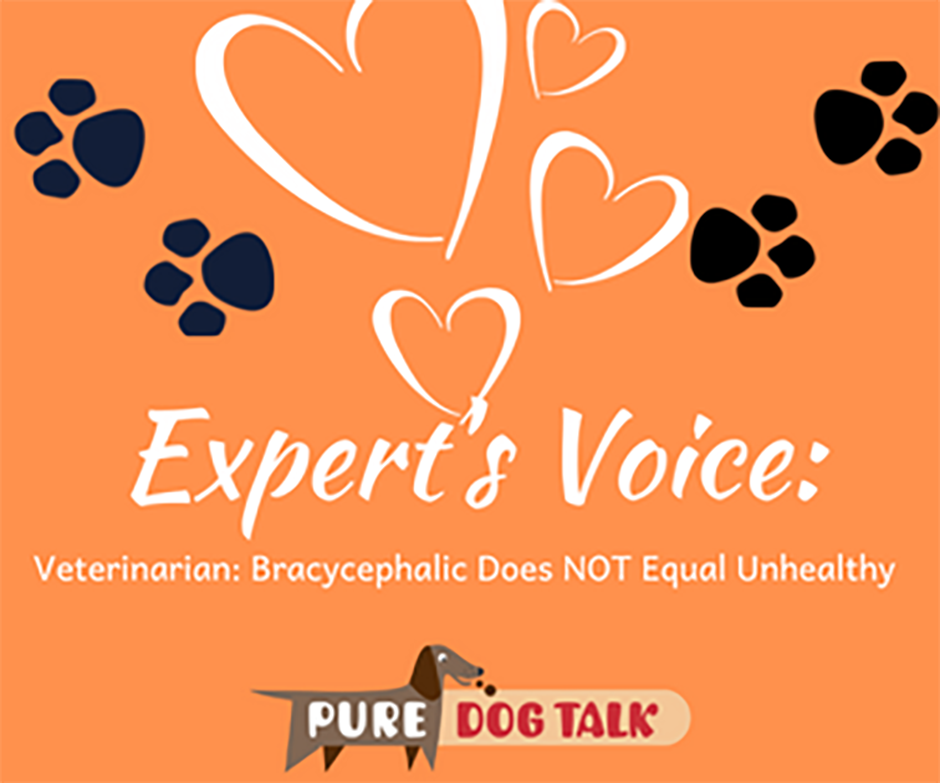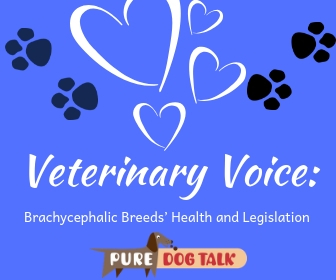517 — Veterinarian: Brachycephalic Does NOT Equal Unhealthy
Veterinary Insight on Why Brachycephalic Does NOT Equal Unhealthy
Dr. Maryanne Mack, DVM, breeder of top winning Boston Terriers, joins host Laura Reeves to discuss recent developments in Europe in regards to legislating the breeding of specific breeds.
“I went to vet school because I love purebred dogs,” Mack said. “I love their role as companions and I wanted to go to vet school really to focus on that role of the dog in our life… Just really wanting to work with people and their pets and breeders as well to just make healthier companions for all of us.
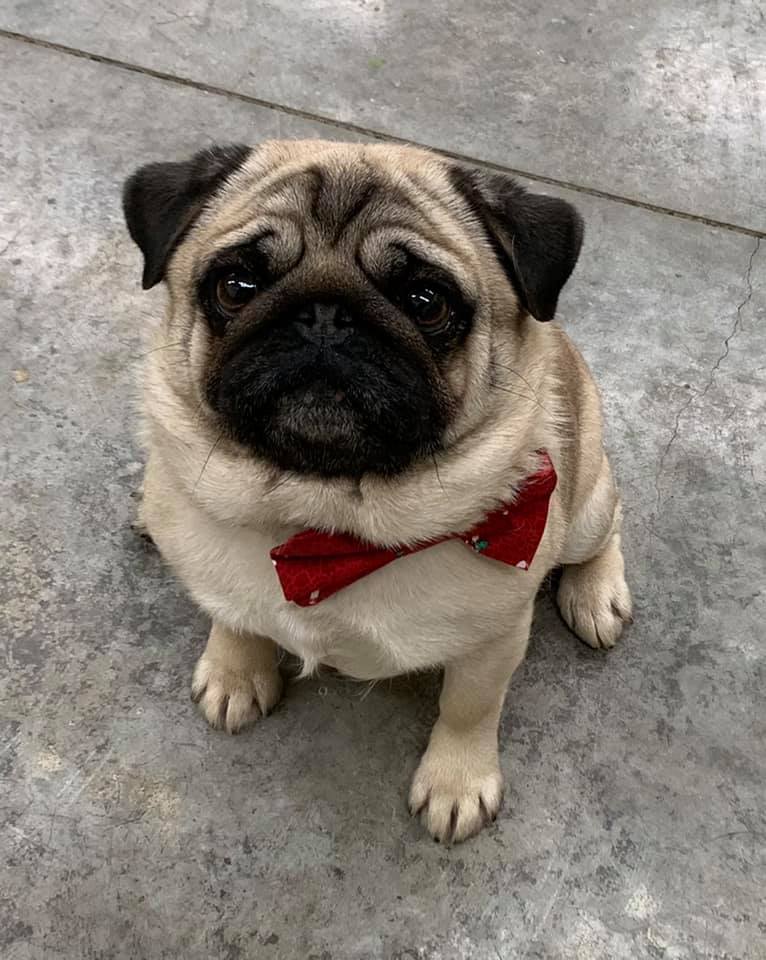
Photo of host Laura Reeves’ champion pug who likes to catch mice in her spare time.
“I think that the fact that a lot of groups have started to associate having a short face with being unhealthy is a really slippery slope that we don’t wanna go down. There’s a couple components of brachycephalic airway syndrome. Those are stenotic nares, or really tight nostrils, an elongated soft palate and a hypoplastic trachea. Those are sort of the three main issues that you see with brachycephalic airway syndrome.
“We don’t have any studies showing those are directly related to the length of the nose.
“The component that we really have to look for, that we know make the biggest difference in these dogs, is the elongated soft palate…
“That’s not related to how long the nose is, that’s related to different genes that are writing for the length of the soft palate. We see long soft palates in dogs with long noses. We see this in Labradors, we see this in mixed breed dogs. So, it’s not only a brachycephalic issue.
“I think it’s really important to note that these things can occur in any breed of dog. They do happen to occur more in brachycephalic dogs, but we don’t have concrete evidence that it’s directly related to the length of the nose.
“Most brachycephalic breeds, with the exception of some of the more mastiff types, these dogs were bred to be companions. That’s their job and they do that very, very, very well. Part of the reason we love them so much is that these brachycephalic facial features elicit almost an infantile like response to people. I think that focusing on the fact that these are companion dogs.
“These dogs are not out flushing birds, they’re not working dogs, they are meant to make people happy, sit on your lap. I absolutely believe that they should be able to do things like go on a little hike …. they should absolutely be able to do that and be able to breathe while they do that. But this is not a dog that’s out herding sheep in the summer. I think keeping that in perspective is really important.
“I think we need to focus, as preservation breeders, on doing a little bit of a better job on selecting breeding stock and producing healthier versions of every breed. But for brachycephalic, specifically, we all know that there are some dogs out there that are not good breathers and that happens.
“I think the hard part as a breeder is to say ‘OK this dog might be beautiful, this dog might have a great top line and this has great movement but he cannot breathe and I should probably put him in a companion home where he won’t be bred.’ That’s a really, really hard decision to make, but I think as we move forward, especially in this new culture and climate, we have to make more of those decisions.
Preservation Breeders are the Solution
“We as preservation breeders are actually the solution. We are the solution to this problem. If we work together to breed healthier dogs and if we work together to breed more of these dogs… I can’t tell you how many of my clients come in with a puppy mill puppy and they say ‘Well Dr. Mack, you told us some great breeders but we didn’t wanna wait for three years, so we ordered this one online and picked it up at the airport and here he is.’
“It breaks my heart because we as preservation breeders, if we had more available dogs that were well bred, people would buy them and they would love them. Vilifying people that breed more than one to two liters a year or whatever number you’ve decided is too many I think is detrimental to all of us.
“I first posted a statement in the beginning of 2020 basically saying I’m a veterinarian, I breed these dogs and it can be done right. These dogs are not inherently unhealthy. I received enormous backlash basically saying this veterinarian shouldn’t be a veterinarian, how can any veterinarian promote the breeding of brachycephalic dogs. It went so far as to contact my place of work, contacting me personally. I had to take my website down. I had to make everything private. I had to tell people who had wanted me to be an advocate for this I can’t do it right now because they’re coming for me.
“In the veterinary community I get backlash like ‘how can you breed these dogs.’ Oftentimes these people, once they meet my dogs and realize they can breathe and they’re healthy and they look great, they realize that we see a disproportionate number of unhealthy dogs just by the nature being veterinarians.
“I’ve actually done a little self-study where a dog comes to see me and I always find out where the dog came from. Then I make a note what issues does this dog have. About 95% of brachycephalic dogs I see that are bad breathers are from a pet store, a puppy mill or rescue. That is just the fact that I’ve gotten over six years of being a veterinarian, that these dogs are often the ones that they ordered online.”
Listen to this fabulous interview with Bulldog specialist Jay Serion to learn more about the Bulldog Club of America’s work on breeding healthy dogs. And this outstanding Love the Breeds episode with more information about Pugs from three nationally renowned breeders.
294 – Veterinary Voice: Brachycephalic Breeds’ Health and Legislation
Veterinary Voice: Brachycephalic Breeds’ Health and Legislation
Dr. Marty Greer visits with host Laura Reeves about the health and recent international legislation impacting Brachycephalic breeds.
Pugs In Holland
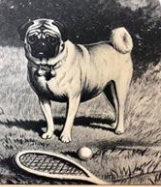
Pug circa 1879. Our thanks to PureDogTalk listener Kelly Schur for making these images available.
Recently the Dutch Pug Club announced, with immediate effect, that the breeding of any pug with a nose less than a third of the length of the skull has been banned.
The following information regarding the breeding of Brachycephalic dogs in Holland is gleaned from several Dutch websites using Google translate:
It has been against the law in Holland since 2014 to breed flat-faced dogs but the government has recently announced they will now be checking dogs, which has triggered this change.
The ban affects popular dog breeds. In the very short term, according to the Dutch legislation, the muzzle of the following dog breeds must be adjusted: French Bulldog, Pug, Boston Terrier, English Bulldog, Shih Tzu and Pekingese. In the longer term, targeted breeds also include the Boxer, Bordeaux Dog, Bullmastiff, Chihuahua, Cavalier King Charles Spaniel and the Yorkshire Terrier .
“It has actually been forbidden since 2014 to keep breeding short snouts, but the ministry has now announced that they will actually check it,” according to Milo Laureij of Dier & Recht. Dier & Recht is a lobbying group that advocates against purebred dogs, insists that wrinkles and flat faces are “harmful” to dogs and “Requires breeders to prevent hereditary disorders.”
Muzzle length
According to the new criteria from the Dutch Pug Club, the muzzle of a dog must be at least a third of the head. That means the end of the pug as it is now being bred in Holland, but also, for example, of the popular English and French Bulldogs and twenty other breeds.
End of breeding
For Commedia, the Dutch association of breeders of Pugs, the new policy is a reason to stop breeding immediately – before enforcement has come into effect. “Since the Ministry believes that breeding dogs with harmful external characteristics has been banned since the entry into force of the Decree on Holders of Animals (2014), we must also conclude that our internal regulations were in part in conflict with and this decision,” the breed club writes on its website.
New breeding program
“Together with the Expertise Center for Genetics Companion Animals, we are now going to put together a breeding program to find out how we can make the pug meet the requirements of the legislator within a number of generations,” said chairman Arjan Sterk. According to him, the breeders reacted differently to Commedia’s decision. “They all understand, but there is always anger and disappointment. But I have not heard that people drop out.”
Traffic light system
The ministry uses a traffic light system with the colors red, orange and green. Red applies to dogs with a snout length shorter than a third of the skull, such as the pug and English and French bulldog. Breeding with these dogs is prohibited immediately. Orange applies to dogs with a muzzle length of a third to half the skull. With this, breeding is only allowed if they meet other criteria that are set for breeding. ‘Green’ dogs have a snout that is at least half the size of the skull. You can breed with this.
Shock waves in U.S.
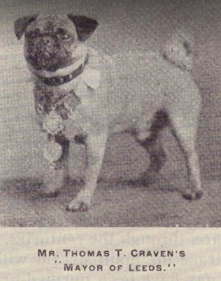
Pug circa 1910. Our thanks to PureDogTalk listener Kelly Schur for making these images available.
Greer noted that National Animal Interest Alliance (NAIA) is actively working to encourage awareness by breeders and purebred dog enthusiasts in the U.S. and elsewhere about this type of animal rights extremism and its looming potential impact here.
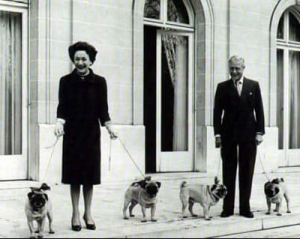
Duchess of Windsor’s Pugs … late 1800s. Our thanks to PureDogTalk listener Kelly Schur for making these images available.
Pugs are an ancient breed from China, the appearance of which has changed little in 150 years.
From the Pug Dog Club of America, “The Pug is of Chinese origin and dates back to the pre-Christian era. They were prized possessions of the emperors of China and lived in a most luxurious atmosphere and at times were even guarded by soldiers. Records show that three types of short-nosed dogs were bred by the Chinese. They were the Lion dog, the Pekingese and the Lo-sze. The Lo-sze or “Foo Dog” was the ancient Pug.”

